Team Vole: Linking observational, experimental and modeling to assess herbivore impacts on C-cycling in northern Alaska
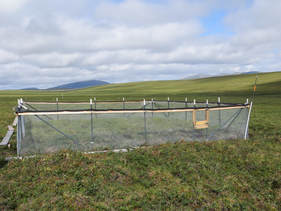
Although numerous studies are examining the effects of high rates of global change in arctic ecosystems, few studies have considered how small mammals may influence these outcomes, despite recent evidence that animals can significantly influence tundra functioning, and may have the potential to exacerbate or mitigate climate driven changes. A collaborative project funded by NSF-PLR, seeks to quantify and gain a mechanistic understanding of the role of small mammal herbivores, such as voles and lemmings, on carbon and nutrient dynamics in the rapidly changing Alaskan arctic tundra and incorporate these impacts into a biogeochemical model to make future predictions of how the animals mediate the tundra-atmosphere carbon exchange.
We will achieve these goals by quantifying natural rodent population densities, experimentally manipulating rodent density with exclosures and enclosures, and measuring rodent impacts on a suite of variables for vegetation, litter, and soil nutrients along a latitudinal gradient with sites on the Seward Peninsula, in the northern foothills of the Brooks Range, and on the arctic coastal plain near Utqiaġvik. The field sites and experiment infrastructure for this project was established in summer 2017 and the experiment is funded through 2023.
Follow our team's progress on Facebook and Twitter @TeamVole
Here are some of Team Vole's recent publications: Rastetter et al. 2021; Roy et al. 2022; Koltz et al. 2022
We will achieve these goals by quantifying natural rodent population densities, experimentally manipulating rodent density with exclosures and enclosures, and measuring rodent impacts on a suite of variables for vegetation, litter, and soil nutrients along a latitudinal gradient with sites on the Seward Peninsula, in the northern foothills of the Brooks Range, and on the arctic coastal plain near Utqiaġvik. The field sites and experiment infrastructure for this project was established in summer 2017 and the experiment is funded through 2023.
Follow our team's progress on Facebook and Twitter @TeamVole
Here are some of Team Vole's recent publications: Rastetter et al. 2021; Roy et al. 2022; Koltz et al. 2022
Nitrogen Deposition in the Chihuahuan Desert
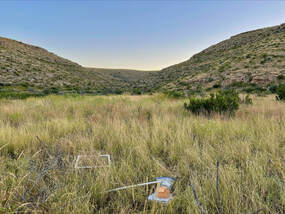
With a grant from the National Park Service we are working to determine at what level of N-addition we begin to observed consequences on vegetation composition and coupled biogeochemical cycles (i.e., Critical Load) and also whether deposition affects the abundance of invasive grasses in Carlsbad Caverns National Park. Carlsbad Caverns NP is currently experiencing increased levels of N-deposition resulting from oil and gas wells in the areas immediately adjacent to the park. Anthropogenic N-addition can reduce biodiversity, alter ecosystem functioning, and contribute to major environmental problems such as reduced drinking water quality and increased emissions from soil of nitrogenous greenhouse gases. We have a notably incomplete understanding of how N deposition will affect dryland ecosystems (arid and semi-arid regions).
Dryland Critical Zone: The role of pedogenic carbonates in water dynamics and nutrient cycling in dryland systems
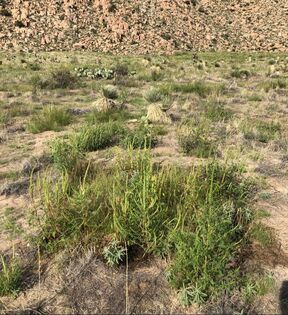
Drylands, with arid to semi-arid climates, cover 45% of the Earth and provide homes to more than 2 billion people. The drylands of the American West are facing significant challenges caused by global change, such as drought and changing plant communities.
This project centers around the multifaceted roles of pedogenic carbonates in dictating vadose zone water dynamics, the potential recharge to deep water table, and nutrient cycling in typical dryland landscapes
As part of the Dryland Critical Zone "thematic cluster," our lab focuses on how nutrient cycling is impacted by pedogenic carbonates, particularly phosphorus limitation. We have established a nutrient addition experiment in the Jornada LTER to determine whether plant and microbial communities experience phosphorus limitation in the Chihuahuan Desert.
Dryland CZ PIs: Lixin Jin, Anthony Darrouzet-Nardi, Lin Ma, Jennie McLaren, Vanessa Lougheed
This project centers around the multifaceted roles of pedogenic carbonates in dictating vadose zone water dynamics, the potential recharge to deep water table, and nutrient cycling in typical dryland landscapes
As part of the Dryland Critical Zone "thematic cluster," our lab focuses on how nutrient cycling is impacted by pedogenic carbonates, particularly phosphorus limitation. We have established a nutrient addition experiment in the Jornada LTER to determine whether plant and microbial communities experience phosphorus limitation in the Chihuahuan Desert.
Dryland CZ PIs: Lixin Jin, Anthony Darrouzet-Nardi, Lin Ma, Jennie McLaren, Vanessa Lougheed
Warming and Removal in Mountains (WARM)
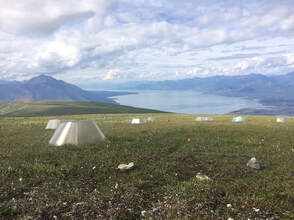
The WARM network is an organized group of scientists with a common interest in assessing terrestrial ecosystem responses to climate change. We have developed a network of sites at which a simple yet powerful temperature manipulation (warming) x species removal experiment has been developed along an elevational gradient to develop predictions about how climate change and the effects of dominant species interact to influence above- and below-ground community structure and mediate key ecosystem processes.
There are 13 sites in montane ecosystems worldwide – I am the lead investigator for the site in northern North America (Yukon Territory, Canada). The network relies on standardized treatments and measurements to compile a global data set for meta-analysis. The current goal of the project is to run all sites for five years, resulting in a powerful set of coordinated data across a wide geographic gradient.
You can read more about the WARM network here.
WARM PIs: Aimee Classen, Nate Sanders, Maja Sundqvist, Toke Hoye, David Wardle, Jennie McLaren, Thomas Crowther, Mariano Rodrigues-Cabal, Mark Hovenden, Julie Deslippe, Jin-Sheng He, Christian Rixen, Soya Wipf, John-Arvid Grytnes, Sandra Lavorel, Noelia Barrios
There are 13 sites in montane ecosystems worldwide – I am the lead investigator for the site in northern North America (Yukon Territory, Canada). The network relies on standardized treatments and measurements to compile a global data set for meta-analysis. The current goal of the project is to run all sites for five years, resulting in a powerful set of coordinated data across a wide geographic gradient.
You can read more about the WARM network here.
WARM PIs: Aimee Classen, Nate Sanders, Maja Sundqvist, Toke Hoye, David Wardle, Jennie McLaren, Thomas Crowther, Mariano Rodrigues-Cabal, Mark Hovenden, Julie Deslippe, Jin-Sheng He, Christian Rixen, Soya Wipf, John-Arvid Grytnes, Sandra Lavorel, Noelia Barrios
Long-term Experiments: Top-down Bottom-up control on the boreal forest understory
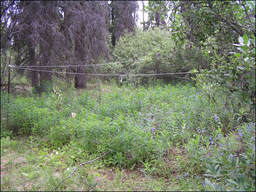
The long-term goal of this project has been to examine the structure and function of biological communities, specifically the understorey of the Boreal Forest. Specifically, we examined if the plant community is organized primarily by nutrient limitation (bottom-up regulation), by herbivory (top-down regulation), or by their interaction. Experiments are designed to manipulate the soil (nutrient level), plant, and the herbivore trophic levels and observe the consequences on the populations or biomass of other trophic levels. This experiment was established by my PhD advisor, Roy Turkington (University of British Columbia) in 1990; after 10 years the treatments in 1/2 of each plot were discontinued. Plant species abundance, composition and diversity were monitored yearly for the first 20 years of the experiment. I began collaborating on this project in 2003 as a PhD student, and became the lead investigator on this project in 2014. These plots also remain available for future projects by graduate and undergraduate students.
Effects of Increasing Shrub Abundance on Multiple Ecosystems
Plant community change is occurring in parallel in two ecosystems in which we focus our research: tundra and desert plant communities. Both of these ecosystems are undergoing a transition from a system dominated by grasses to one dominated by woody plants. Arctic and alpine ecosystems are currently undergoing a number of rapid ecological changes driven by global changes in climate, whereas the changes in desert communities are largely driven by changes in land management.
Alpine Tundra
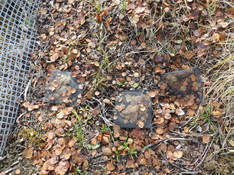
Increases in shrub abundance have already been shown to alter tundra ecosystem function both directly and indirectly by altering biotic (e.g. interaction with herbivores, litter inputs and canopy structure and abiotic controls (modified snow characteristics and shading). The research in my lab currently focuses on impacts of shrubs caused by increasing litter inputs. Students in my lab have used a manipulative experiment examining shrub litter depth in combination with shrub removals to separate the effects of the shrubs as a whole from the direct effects of their litter input. You can read Daniela Aguirre's paper from this experiment here.
Arctic Tundra
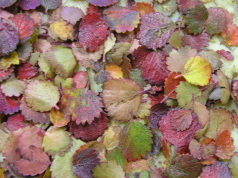
Much of my research on this question in arctic tundra has taken advantage of a chrono-sequence of long-term fertilization experiments (ranging from 5 to 22 years of fertilization) with corresponding levels of shrub density. I have explored the effects of shrub increases on litter decomposition (link), depth-to-permafrost, nitrogen cycling and seasonality, among other ecosystem properties. Much of this work was in collaboration with Laura Gough at Towson University.
Chihuahuan Desert
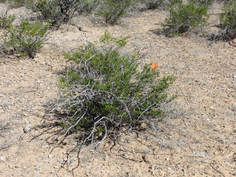
Because of the high proportion of slow -decomposing woody tissue in shrubs compared with grasses, shrub encroachment may change the amount of carbon (C) stored in desert ecosystems. Arid and semi-arid ecosystems cover over 40% of the Earth’s land surface, and even small changes in the carbon balance in these ecosystems can result in large global influences. My students and I have been examining these potential effects in collaboration with Brandon Bestelmyer from the USDA and the lab of Anthony Darrouzet-Nardi at UTEP. Using an on-going large-scale shrub removal conducted by the USDA we have examined both the influences of shrubs on soil microbial activity, but also factors which may stall the recovery of these ecosystems after shrub removal.
